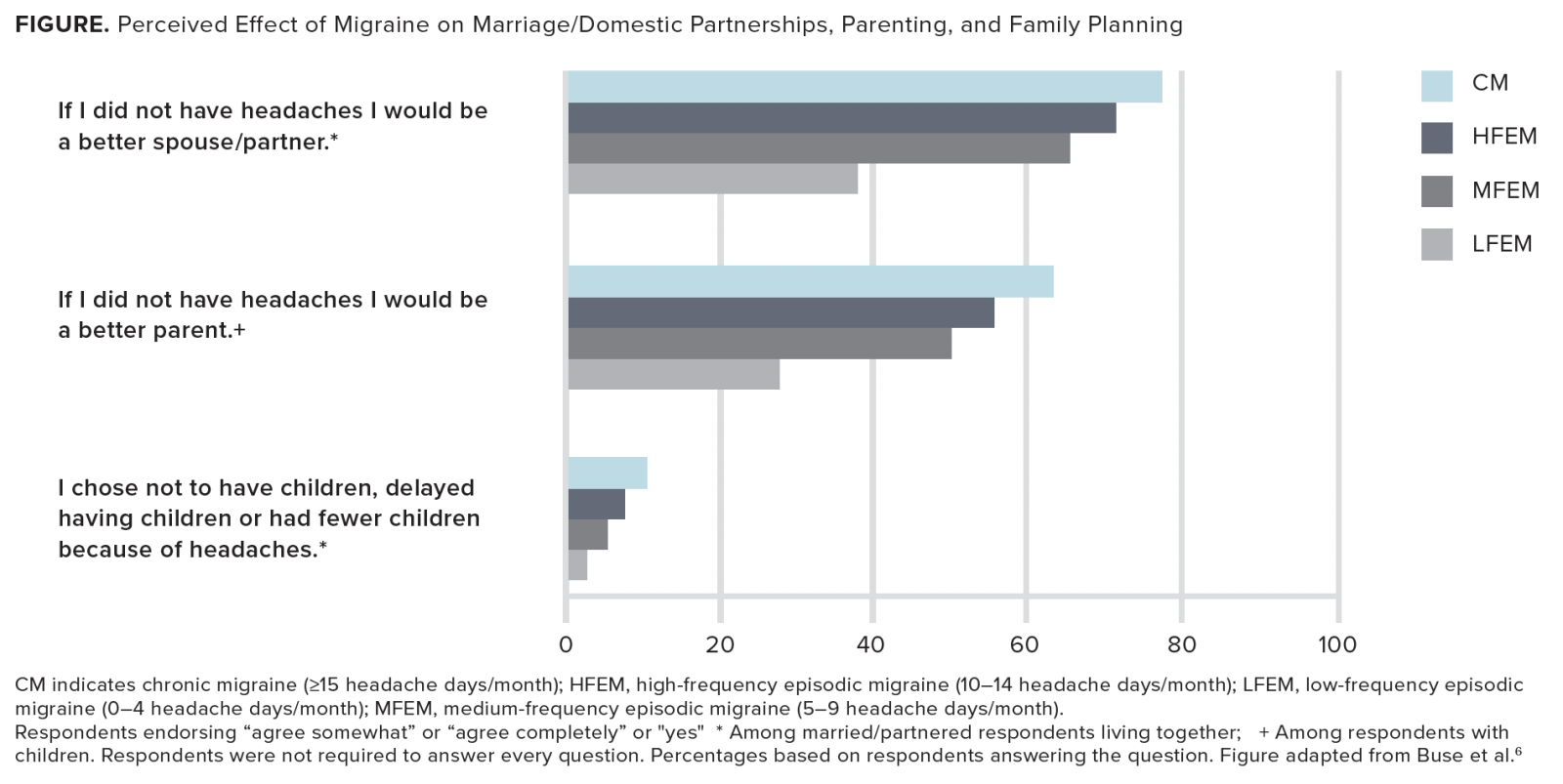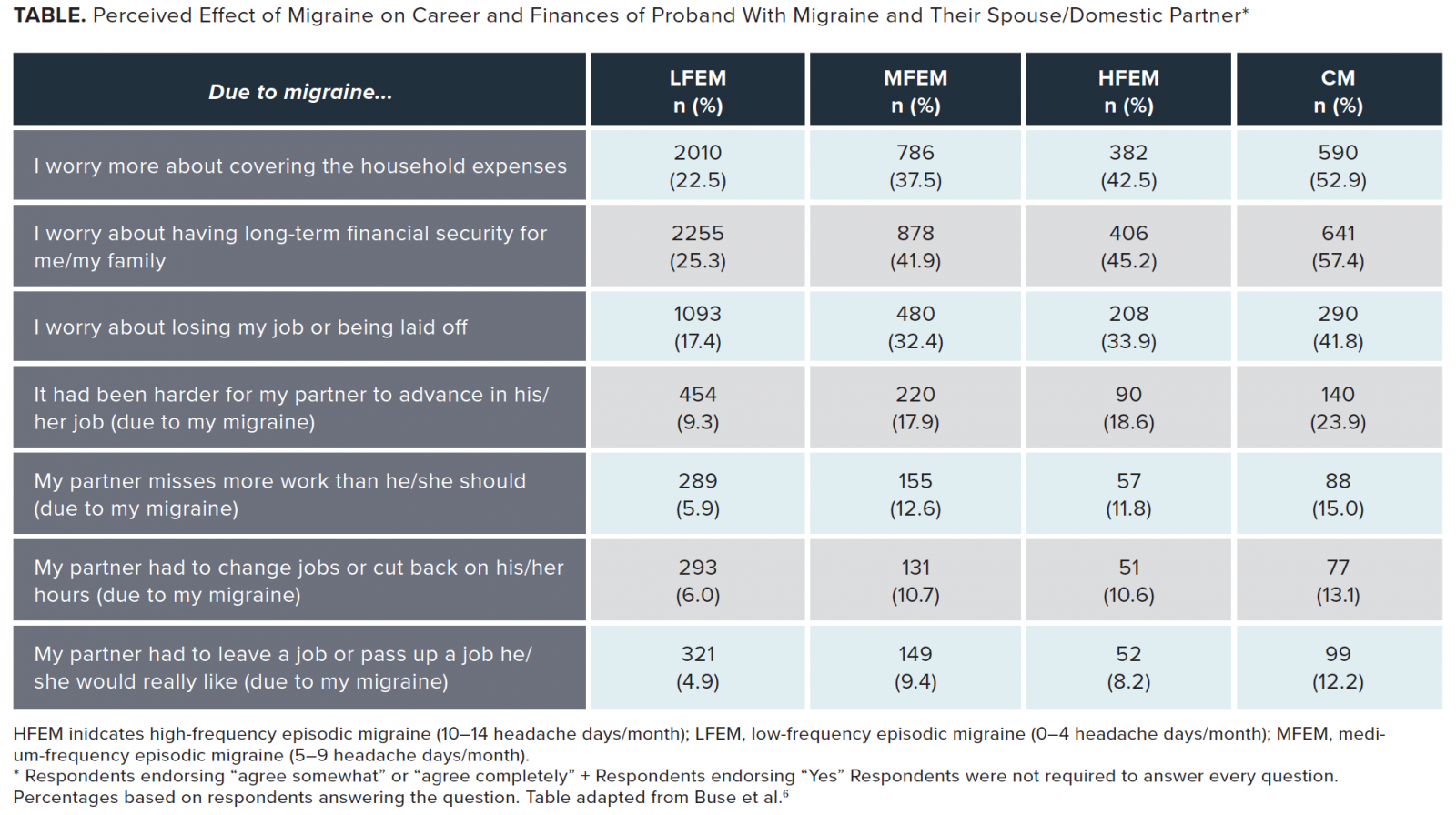Publication
Article
NeurologyLive
A Big-Picture Look at the Burden of Migraine
Author(s):
Reducing the frequency of migraine is only 1 step in the process of optimizing management and addressing the disease's impact on patients’ lives.
Dawn Buse, PhD, Clinical Professor, Department of Neurology, Albert Einstein College of Medicine, Board Member at Large, American Headache Society

Dawn Buse, PhD
More than 1 billion people live with migraine. The condition not only has an impact on probands but, like a stone thrown into a still lake, can also negatively affect others in widening concentric circles, including family members, friends, coworkers, employers, health care providers, and systems and society. Analysis of the 2016 Global Burden of Disease (GBD) data revealed that migraine was the second-most-disabling disease on the planet, following low back pain.1 The data estimated that migraine caused 45.1 million years lived with disability (YLDs) in 2016 alone. Disability was highest in women between the ages of 15 and 49, with 20.3 million YLDs in this group because of migraine. Disability is assessed as a function of the percentage of time lost because of a disease divided by the total amount of responsibilities, activities, and commitments. Therefore, the burden of migraine is amplified because migraine prevalence is highest in midlife, when work and family productivity, responsibilities, and demands are at their peak. During these decades, people may be juggling careers, advanced educations, and families and may be caring for both children and aging parents. This level of commitment and responsibility establishes potential for great associated disability in multiple important domains.
Understanding the Impact of Migraine
The burden of migraine occurs both ictally (during) and interically (between attacks).2,3 The ictal burden is largely characterized by disability and limitations directly due to head pain and associated symptoms such as nausea, vomiting, and sensitivity to environmental stimuli, as well as potential cognitive impairment and other symptoms during the prodrome and postdrome phases. The interictal burden manifests in cognitive, psychological, and emotional symptoms roughly when the next attack may occur and a resulting reluctance to make plans or commitments along with potential symptoms of an activated trigeminovascular system.4,5 This interictal burden is associated with medication overuse, anxiety, depression, lowered quality of life, and both big and small impacts in all important areas of life, such as academic and occupational achievement, relationships and family planning, and financial status. For example, 9.6% of respondents with chronic migraine (CM) from the Chronic Migraine Epidemiology and Outcomes (CaMEO) Study reported that they chose to not have children, delayed having children, or had fewer children because of migraine.6
Other recent US and international studies have revealed further far-reaching negative impacts that migraine can have on important areas of life. Like results of the CaMEO Study, the recent My Migraine Voice study, a global study of people with migraine for whom preventive treatments have failed, reported that approximately half of respondents noted missing important events and avoiding making commitments because of migraine. It also found that migraine had negative impacts on intimacy and respondents’ sex lives.7 Also in alignment with CaMEO, a study of populations from both the United States and the United Kingdom reported that individuals with migraine were more likely to argue with their children and partners and felt less involved in their children’s lives both at home and at school because of migraine.8
Migraine can have a substantial negative impact on educational achievement, career success, and financial status as well.9-14 In data collected from headache centers in Austria, 34.0% of respondents reported that “headaches” had a negative impact on their careers and 21.5% reported negative impacts on financial earnings. Only 50.0% of respondents believed that colleagues accepted their headaches, highlighting the stigma experienced by individuals with migraine.12 The burden of migraine is significantly and consistently higher for people with CM who have greater headache-related disability, headache impact, and decrements in health-related quality of life (HRQOL); higher rates of comorbidities; increased health care resource utilization; higher direct and indirect costs; lower socioeconomic status; and a greater negative impact on educational attainment, career, personal and household finances, family stress, and stigma because of migraine compared with people with episodic migraine.9,15-18

Furthermore, migraine affects not only the individual with the disease but also the relationships and interpersonal dynamics, psychological health and well-being, achievements, and financial stability of the entire family, most notably spouses/partners and children (FIGURE).6-8,11,19-23 Adolescent children of parents with migraine from the CaMEO Study reported negative impacts on school participation, participation in extracurricular activities such as sports and social activities, and relationships with family members and friends because of a parent’s migraine.20 Migraine can have negative effects on academic and occupational achievement, career success, and financial attainment of the spouses/partners of probands with migraine as well (TABLE).6,19 In parallel to patterns seen with probands, the burden of migraine on the proband’s family members is highest among probands with CM.12,20
What You Can Do
In light of the abundance of evidence coupled with clinical reports directly from patients, importantly, health care professionals caring for individuals with migraine must assess the burden of disease on individuals and their families and intervene when appropriate. Successful treatment that results in reduction of headache days is associated with reduction in headache-related disability as well as reduction in depression and anxiety and improvements in HRQOL.24 In addition, direct intervention may be warranted via cognitive behavioral therapy or other educational intervention for probands and/or families.21

Assessment and ongoing monitoring of disability is essential for optimized treatment planning.25,26 Simply opening with “Tell me about your headaches and how they affect your life” is effective in establishing a dialogue about headache-related disability and patient values that improves treatment planning, rapport, and patient and provider satisfaction while shortening visit length.26 Openly discussing and normalizing the challenges associated with living with a painful and unpredictable chronic disease can help destigmatize disability.
A range of validated generic and disease-specific instruments exist to aid in the assessment of disability, HRQoL and management of migraine.27 The Migraine Disability Assessment scale measures lost time due to headache in work and school, household work and chores, and family, social, and leisure activities and is free for use.28 The Headache Impact Test is a copywritten questionnaire that assesses activity limitations, pain severity, fatigue, frustration, and difficulty with concentration due to headache.29 The Migraine Physical Function Impact Diary and the Migraine Functional Impact Questionnaire are novel patient-reported outcome measures for assessing the impact of migraine that incorporate 2009 FDA guidance on development of patient-reported outcomes for inclusion in clinical trials,30-32 and the Impact of Migraine on Partners and Adolescent Children scale was developed from the CaMEO Study to assess and monitor the family burden of migraine.33
Dawn Buse, PhD, is a clinical professor in the Department of Neurology at Albert Einstein College of Medicine and a Board Member at Large of the American Headache Society.
REFERENCES
1. GBD 2016 Headache Collaborators. Global, regional, and national burden of migraine and tension-type headache, 1990-2016: a systematic analysis for the Global Burden of Disease Study 2016. Lancet Neurol. 2018;17(11):954-976. doi: 10.1016/S1474-4422(18)30322-3.
2. Buse DC, Rupnow MFT, Lipton RB. Assessing and managing all aspects of migraine: migraine attacks, migraine-related functional impairment, common comorbidities, and quality of life. Mayo Clin Proc. 2009;84(5):422-435. doi: 10.1016/S0025-6196(11)60561-
3. Lampl C, Thomas H, Stovner LJ, et al. Interictal burden attributable to episodic headache: findings from the Eurolight project. J Headache Pain. 2016;17:9. doi: 10.1186/s10194-016-0599-8.
4. Buse DC, Bigal MB, Rupnow M, Reed, M, Serrano D, Lipton RB. Development and validation of the Migraine Interictal Burden Scale (MIBS): a self-administered instrument for measuring the burden of migraine between attacks [abstract S05.003]. Neurology. 2007;68(suppl 1): A89.
5. Buse DC, Greisman JD, Baigi K, Lipton RB. Migraine progression: a systematic review. Headache. 2019;59(3):306-338. doi: 10.1111/head.13459.
6. Buse, DC, Fanning KM, Reed, ML, et al. Life with migraine: effects on relationships, career, and finances from the Chronic Migraine Epidemiology and Outcomes (CaMEO) Study [published online August 12, 2019]. Headache. doi: 10.1111/head.13613.
7. Martelletti P, Schwedt TJ, Lanteri-Minet M, et al. My Migraine Voice survey: a global study of disease burden among individuals with migraine for whom preventive treatments have failed. J Headache Pain. 2018;19(1):115. doi: 10.1186/s10194-018-0946-z.
8. Lipton RB, Bigal ME, Kolodner K, Stewart WF, Liberman JN, Steiner TJ. The family impact of migraine: population-based studies in the USA and UK. Cephalalgia. 2003;23(6):429-440. doi: 10.1046/j.1468-2982.2003.00543.x.
9. Santos IS, Brunoni AR, Goulart AC, Griep RH, Lotufo PA, Benseñor IM. Negative life events and migraine: a cross-sectional analysis of the Brazilian Longitudinal Study of Adult Health (ELSA-Brasil) baseline data. BMC Public Health. 2014;14:678. doi: 10.1186/1471-2458-14-678.
10. Steiner TJ, Stovner LJ, Katsarava Z, et al. The impact of headache in Europe: principal results of the Eurolight project. J Headache Pain. 2014;15:31. doi: 1186/1129-2377-15-31.
11. Dueland AN, Leira R, Burke TA, Hillyer EV, Bolge S. The impact of migraine on work, family, and leisure among young women—a multinational study. Curr Med Res Opin. 2004;20(10):1595-1604. doi: 10.1185/030079904X3357.
12. Zebenholzer K, Andree C, Lechner A, et al. Prevalence, management and burden of episodic and chronic headaches—a cross-sectional multicentre study in eight Austrian headache centres. J Headache Pain. 2015;16:531. doi: 10.1186/s10194-015-0531-7.
13. Allena M, Steiner TJ, Sances G, et al. Impact of headache disorders in Italy and the public-health and policy implications: a population-based study within the Eurolight Project. J Headache Pain. 2015;16:100. doi: 10.1186/s10194-015-0584-7.
14. Lampl C, Thomas H, Stovner LJ, et al. Interictal burden attributable to episodic headache: findings from the Eurolight project. J Headache Pain. 2016;17:9. doi: 10.1186/s10194-016-0599-8.
15. Buse DC, Manack AN, Fanning KM, et al. Chronic migraine prevalence, disability, and sociodemographic factors: results from the American Migraine Prevalence and Prevention Study. Headache. 2012;52(10):1456-1470. doi: 10.1111/j.1526-4610.2012.02223.x.
16. Buse D, Manack A, Serrano D, et al. Headache impact of chronic and episodic migraine: results from the American Migraine Prevalence and Prevention study. Headache2012;52(1):3-17. doi: 10.1111/j.1526-4610.2011.02046.x.
17. Stewart WF, Wood GC, Manack A, Varon SF, Buse DC, Lipton RB. Employment and work impact of chronic migraine and episodic migraine. J Occup Environ Med. 2010;52(1):8-14. doi: 10.1097/JOM.0b013e3181c1dc56.
18. Blumenfeld AM, Varon SF, Wilcox TK, et al. Disability, HRQoL and resource use among chronic and episodic migraineurs: results from the International Burden of Migraine Study (IBMS). Cephalalgia. 2011;31(3):301-315. doi: 10.1177/0333102410381145.
19. Buse DC, Scher AI, Dodick DW, et al. Impact of migraine on the family: perspectives of people with migraine and their spouse/domestic partner in the CaMEO Study [published online April 25, 2016]. Mayo Clin Proc. doi: 10.1016/j.mayocp.2016.02.013.
20. Buse DC, Powers SW, Gelfand AA, et al. Adolescent perspectives on the burden of a parent’s migraine: results from the CaMEO Study. Headache. 2018;58(4):512-524. doi: 10.1111/head.13254.
21. Seng EK, Mauser ED, Marzouk M, Patel ZS, Rosen N, Buse DC. When mom has migraine: an observational study of the impact of parental migraine on adolescent children. Headache. 2019;59(2):224-234. doi: 10.1111/head.13433.
22. MacGregor EA, Brandes J, Eikermann A, Giammarco R. Impact of migraine on patients and their families: the Migraine And Zolmitriptan Evaluation (MAZE) survey—phase III. Curr Med Res Opin. 2004;20(7):1143-1150. doi: 10.1185/030079904125004178.
23. Smith R. Impact of migraine on the family. Headache. 1998;38(6):423-426.
24. Blumenfeld AM, Tepper SJ, Robbins LD, et al. Effects of onabotulinumtoxinA treatment for chronic migraine on common comorbidities including depression and anxiety. J Neurol Neurosurg Psychiatry. 2019;90(3):353-360. doi: 10.1136/jnnp-2018-319290.
25. Holmes WF, MacGregor AE, Sawyer JPC, Lipton RB. Information about migraine disability influences physicians’ perceptions of illness severity and treatment needs. Headache. 2001;41(4):343-350.
26. Hahn SR, Lipton RB, Sheftell FD, et al. Healthcare provider-patient communication and migraine assessment: results of the American Migraine Communication Study, phase II. Curr Med Res Opin. 2008;24(6):1711-1718. doi: 10.1185/03007990802122388.
27. Buse DC, Sollars CM, Steiner TJ, Jensen RH, Al Jumah MA, Lipton RB. Why HURT? a review of clinical instruments for headache management. Curr Pain Headache Rep. 2012;16(3):237-254.
28. Stewart WF, Lipton RB, Kolodner K, Liberman J, Sawyer J. Reliability of the Migraine Disability Assessment Score in a population-based sample of headache sufferers. Cephalalgia. 1999;19(2):107-114. doi: 10.1007/s11916-012-0263-1.
29. Kosinski M, Bayliss MS, Bjorner JB, et al. A six-item short-form survey for measuring headache impact: the HIT-6. Qual Life Res. 2003;12(8):963-974.
30. Guidance for industry patient-reported outcome measures: use in medical product development to support labeling claims. FDA website. https://www.fda.gov/media/77832/download. December 2009. Accessed August 12, 2019.
31. Hareendran A, Mannix S, Skalicky A, et al. Development and exploration of the content validity of a patient-reported outcome measure to evaluate the impact of migraine—the migraine physical function impact diary (MPFID). Health Qual Life Outcomes. 2017;15(1):224. doi: 10.1186/s12955-017-0799-1.
32. Hareendran A, Skalicky A, Mannix S, et al. Development of a new tool for evaluating the benefit of preventive treatments for migraine on functional outcomes—the Migraine Functional Impact Questionnaire (MFIQ). Headache. 2018;58(10):1612-1628. doi: 10.1111/head.13420.
33. Lipton RB, Buse DC, Adams AM, et al. Family impact of migraine: development of the Impact of Migraine on Partners and Adolescent Children (IMPAC) scale. Headache. 2017;57(4):570-585. doi: 10.1111/head.13028.
Newsletter
Keep your finger on the pulse of neurology—subscribe to NeurologyLive for expert interviews, new data, and breakthrough treatment updates.





